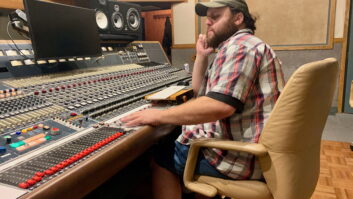The Rackmount Solid-State Recorder Serves As Cassette/DAT/MD Replacement, PC-Based Workstation
(click thumbnail)
The Marantz PMD570 rackmount solid-state recorder is a new breed of broadcast equipment. This standalone device operates as a hybrid between cassette/DAT/MD recorders and as a PC-based digital audio workstation. One way to look at the PMD570 is to see it as a DAW with a dedicated interface to emulate the simplicity and functionality of traditional recorders, but with potential for greater flexibility.
The unit is not a DAW replacement, but rather a significant enhancement to tape-based decks. It works well as a standalone, but the real proof-of-concept comes when integrated with computer-based production setups.
‘More than a sidekick’
The PMD570 builds on the success of the PMD670 field recorder. The basic functions of the PMD570 are nearly identical, although it is repackaged into a 1 RU form factor.
Product CapsuleTHUMBS UP:
Static RAM recorder; no moving parts, tape heads, etc.
Excellent audio quality
Ease of operation
THUMBS DOWN:
Slow USB 1.1 connection
PRICE: $1,099
CONTACT: D&M Professional in Illinois at (866) 405-2154 or visit www.d-mpro.com
Foremost, both models store audio data on affordable Compact Flash (CF) cards, leaving legacy magnetic media behind. That alone makes either unit an attractive upgrade for those still using analog cassettes or DAT recorders.
The selection of recording formats including MP2, MP3, WAV and BWF open up a range of sample and bit rates suitable for most radio applications. The I/O between the units also is similar, with unbalanced RCA analog I/O, RCA SPDIF, a digital USB 1.1 connector and balanced XLR analog inputs.
For a news operation armed with PMD670 recorders, a rackmount version in the studio that can read the field recorder’s track marks makes sense. Standardizing on the Marantz gear means that there is no need to plug anything in to the studio production setup, other than the removable CF card. EDLs recorded in the field can be read in the studio deck. For news operations gathering speedy sound bytes with end-to-end digital production, the PMD670 is your front end in the field, the PMD570 in the studio.
But the PMD570 is intended to be more than a sidekick to the field recorder. It adds important extras to the PMD670 so it serves as a next-generation cassette/DAT/MD recorder replacement. An RS-232C port enables complete PC computer control through a simple utility program. Also, the unit can be set to capture feeds automatically either by programming it for a specific time or to trigger recording whenever sound comes down the line.
With a large CF card and a low bit rate, an enormous amount of airtime can be logged. A 1 GB card recording at the highest MP3 compression setting (32 kbps mono) can capture nearly 71 hours.
A first look at the control panel of the PMD570 may be a bit confusing to the neophyte. It looks similar to the standard tape recorder interface, but with a few mysterious additions. While broadcast engineers will find working through the menu-driven interface easy in setting recording format and quality, air staff might find the task a bit challenging.
Fortunately, the PMD570 lets you program presets so it is easy to switch between inputs and recording formats. Instead of asking less technically sophisticated staff to figure out the bits and bytes of audio compression, they just snap the “rec level/select” knob to the proper preset to get going. Add the PC-based software controls (sorry, no Mac version yet) through the RS-232C and you have remote operation. A wired remote will be offered.
Recordings made through balanced XLR or unbalanced RCA inputs are as clean and crisp as the quality of the audio format chosen. Even when driven into overmodulation with an archived cassette recording turned up too high, the PMD570 rendered a nice, unclipped-sounding digital audio file. Basically, it lives up to the promise of creating computer-based audio without a computer.
Wish list
When I first heard about the PMD570, I didn’t understand the idea of it. If you’re doing digital recording in the studio, why not use a DAW?
But after seeing it in operation, I appreciate the appeal that this will have used in tandem with the matching field recorder, and as a standalone. It effectively bridges the gap between rackmount recorders developed in the analog era and our computer-based production.
That being said, I would suggest a few changes or upgrades to realize its potential fully.
First, it would make sense to add balanced XLR analog outs. That is, after all, standard on the decks PMD570 replaces. This is a moot point for those transferring audio digitally through the USB connection, as the analog outs are just used for monitoring anyway. In that case, why not upgrade the USB 1.1 connector from the field recorder into USB 2.0 or Firewire (IEEE-1394)?
When you start using large CF cards (first accessory – a larger card than the 64 meg included), moving large files over the slower USB standard is unnecessarily time-consuming. Given that the PMD570 supports FAT 32 to work with CF cards over 2 GB, having a fatter data pipe is appropriate.
The last item on the wish list to make the unit up-to-speed with current computer technology is to swap the RS-232C control interface for an Ethernet connector. If the PMD570 were an IP device, remote operation would be enormously expanded. Instead of having a single control from a single computer through a dedicated cable, a Web interface could access the unit throughout a facility – and beyond. Oh, and with a gigabit Ethernet interface, you also can toss out the USB 1.1 connector altogether.
The PMD570 marks a significant evolution in the rackmount recorder. Anyone in the market considering cassette/DAT/MD units would do well to check this out.








